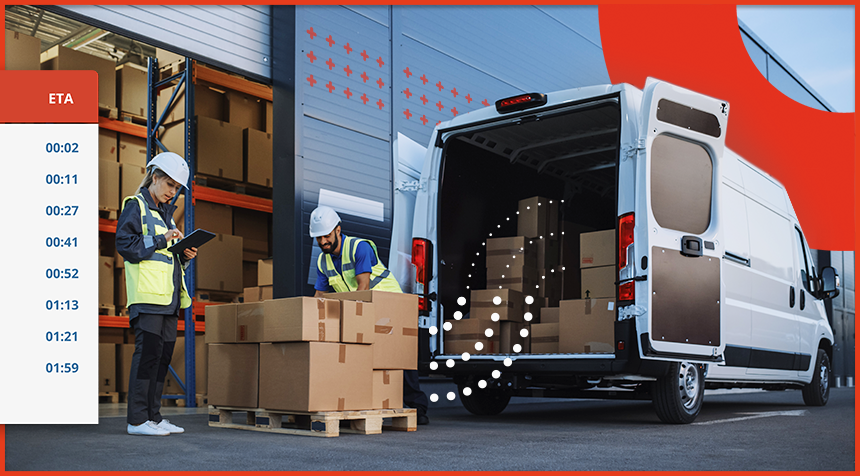Key takeaways
- Knowing the main elements that affect price is crucial for controlling the cost of LTL freight shipment.
- Dimensions, weight, freight class, distance, and other factors all have a big impact on the total cost of shipping.
- Businesses may improve their shipping tactics and cut down on needless expenditures by assessing these variables and making strategic decisions based on this knowledge.
- There are several approaches to reduce expenses and improve the effectiveness of supply chain operations, from examining previous shipment data to putting effective packing techniques into practice.
- Reducing transportation expenses and achieving cost-efficiency also require using technology for route optimization and carrier pricing negotiations.
- Through proactive measures and market trend awareness, companies may revolutionize the way they approach freight shipping and set a new standard of excellence in the industry.


Introduction
Comprehending the charges associated with LTL freight shipment is vital for efficient expenditure management. Through the analysis of critical variables like weight, dimensions, freight class, and distance, companies may strategically optimize their shipping plans and cut costs. Cutting expenses and improving supply chain efficiency include putting effective packing techniques into place, utilizing technology for route optimization, and haggling over charges with carriers. Businesses that concentrate on these tactics can enhance their transportation network, delivery time, and customer happiness in addition to making financial savings. It all comes down to revolutionizing how companies handle freight shipping and establishing new benchmarks for excellence in the sector.
Understanding LTL Freight Shipping Costs
To properly manage your spending, you must have a thorough awareness of the elements that affect LTL freight shipping rates. The total cost of transportation is influenced by a number of factors, including freight class, weight, size, and distance. You may save needless costs by strategically optimizing your shipping tactics by thoroughly examining these elements and understanding their ramifications.
Making educated judgments that can result in cost savings is made possible by carefully examining these important factors. For example, by extensively analyzing the distance traveled by your goods, you may find ways to combine delivery or look into more affordable routes. Comparably, by packing your freight well and eliminating needless expenditures associated with dimensional weight, you may minimize the influence that weight and dimensions have on transportation prices. Additionally, knowing the freight class of your shipments helps you choose the best services and carriers based on your needs and budget.
Basically, having a solid grasp of these important variables gives you the ability to make well-informed strategic decisions that reduce LTL freight shipping expenses and improve overall effectiveness. of your supply chain operations.
Analyzing your past shipment data is one technique to comprehend the cost of LTL freight transportation. You may improve your shipping strategy by looking at previous shipments to find patterns and trends. Opportunities to combine shipments, use more economical carriers, or modify packaging procedures to lower dimensional weight may become apparent as a result of this research.
It’s also critical to keep up of developments in carrier pricing strategies and industry trends. You may bargain for lower pricing and find places where costs can be cut by being aware of how carriers determine rates and any recent modifications to this process.
Implementing Efficient Packaging Practices
Optimizing LTL freight shipment costs requires the implementation of effective packing strategies. By optimizing your packing techniques, you may lower the dimensional weight of your shipments and utilize fewer extra materials, which will save you money in the long run. Taking sustainability into account when packing and utilizing lightweight, long-lasting eco-friendly materials are two good ways to do this. This contributes to the shipment’s total weight reduction and is in line with eco-friendly procedures.
Additionally, utilizing creative packaging options like stacked pallets or foldable containers may maximize space usage even further, cutting down on the number of shipments required and transportation expenses. Purchasing packing supplies made especially to optimize space efficiency will allow you to minimize the overall volume of your shipments and potentially qualify for lower freight rates based on reduced dimensional weight measurements.
Furthermore, automating your packaging procedures—for example, by using automated packing systems or machines—can assist maintain uniformity in packaging standards and optimize operations. This increases productivity while lowering the possibility of mistakes and damage occurring in transit, which eventually results in cost savings by lowering the need for replacements or reshipments.
Overall, you may successfully lower LTL freight shipping costs while improving the overall efficacy of your supply chain operations by concentrating on efficient packing techniques that give priority to sustainability, space efficiency, and automation.
Using the right box size for your shipments is one method of effective packing. Selecting the appropriate size box can help cut down on wasted space and avoid paying more for dimensional weight. Using strong and long-lasting packing materials may also assist safeguard your cargo and reduce the possibility of damage, which could result in extra expenses.
Optimizing the way that products are stacked and arranged within each package is another technique to think about. You may make the most of the available space and possibly cut down on the number of packages needed for a shipping by organizing things well.
Overall, implementing efficient packaging practices can help you optimize LTL freight shipping costs by reducing dimensional weight charges, minimizing damage-related expenses, and improving overall shipment efficiency.


Leveraging Technology for Route Optimization
The use of technology for route optimization has revolutionized LTL freight transportation in the current fast-paced and cutthroat business climate. Businesses may completely transform their supply chain operations and save a large amount of money by utilizing the power of cutting-edge analytics tools and sophisticated routing software.
These cutting-edge tools explore the complexities of route planning, accounting for a wide range of variables including carrier availability, traffic conditions, and delivery locations. The program may create optimum routes that save needless mileage and fuel expenses in addition to minimizing travel time by precisely assessing these aspects. What was the outcome? a simplified and effective transportation system that lowers costs, speeds up deliveries, and eventually increases customer satisfaction.
Furthermore, technology isn’t limited to route optimization. Businesses may get important visibility into the whereabouts and conditions of their freight with the use of real-time tracking and monitoring tools. Proactive decision-making made possible by this degree of openness enables businesses to swiftly resolve any delays or problems and guarantee seamless and on-time delivery.
Essentially, companies may open up a world of opportunity to improve the efficiency of their supply chain, reduce transportation costs, and simplify operations by utilizing technology for route optimization. It’s not only about cutting costs; it’s also about revolutionizing how companies handle freight shipment and establishing new benchmarks for excellence in the sector.
Software for optimizing routes considers a number of variables, including carrier availability, traffic patterns, and delivery locations. The program can create optimum routes that save travel time and distance by examining these variables. This lowers transportation expenses while simultaneously increasing customer satisfaction and delivery timeliness.
Technology can also make it easier to track and monitor shipments in real time. You may prevent delays and problems by being aware of the whereabouts and current condition of your freight, which will guarantee efficient and punctual delivery.
You may improve the overall efficiency of your supply chain, cut expenses associated with transportation, and streamline your operations by utilizing technology for route optimization.
Negotiating Rates with Carriers
A key to reducing LTL freight shipping expenses and optimizing cost-efficiency in your supply chain operations is to negotiate advantageous rates with carriers. Having solid connections with carriers gives you important insights about their flexibility and pricing policies in addition to assisting in the development of a sense of trust and dependability.
You may find areas for possible cost reductions and negotiate reasonable prices that fit your shipping needs and budget by being aware of the nuances of carrier pricing schemes. By thoroughly investigating market trends and contrasting prices offered by other providers, you can equip yourself with the information you need to have productive conversations with carriers and push for more competitive pricing based on industry standards.
Additionally, think about looking into the possibility of negotiating volume-based discounts or long-term contracts with carriers. Through a strategic relationship or a commitment to regular shipment quantities, you can frequently use these agreements to negotiate better terms and costs that meet your unique requirements.
Another essential element of effective tariff negotiations is keeping lines of communication open with carriers. By communicating with carriers about your shipment volumes, trends, and changing needs, you may establish a cooperative partnership that makes it possible to make continuous enhancements and modifications to pricing arrangements. You can always negotiate the best prices and terms that will ultimately benefit your organization by routinely examining your shipping agreements and looking for optimization possibilities.
.
Compiling and evaluating market data is a crucial step in the rate negotiation process. You might find chances to save money by looking into carrier price patterns and contrasting rates from various suppliers. Equipped with this knowledge, you may ask for better pricing from carriers by referencing market standards with assurance.
Additionally, think about settling on volume-based discounts or long-term agreements with carriers. You may typically negotiate better pricing and terms by committing to regular quantities or forming a long-term partnership.
Recall to keep lines of communication open with carriers and to periodically assess the volume and requirements of your shipments. Over time, you may increase pricing and fortify your connection with carriers by communicating your demands to them and looking for ongoing improvements.
Utilizing Freight Consolidation Services
Using freight consolidation services is a crucial tactic to take into account when trying to minimize LTL freight transportation expenses. Because these services combine several smaller shipments into a single, bigger package, they provide tremendous cost-saving potential. Businesses may take advantage of economies of scale and lower transportation costs by grouping shipments instead of handling individual shipments.
Consolidating freight improves the supply chain’s overall efficiency in addition to lowering costs. Businesses may enhance delivery timelines, expedite processing times, and streamline the transportation process by grouping goods. This not only saves money but also guarantees prompt and effective delivery of items to clients.
Additionally, by lowering the number of cars on the road and streamlining transportation routes, freight consolidation services can aid in lessening the environmental effect of shipping. This adds even more value to the whole supply chain operations by being in line with sustainability goals and eco-friendly methods.
In summary, using freight consolidation services is a calculated move that will maximize LTL freight shipment savings, boost productivity, and lessen the environmental impact of transportation operations. Businesses may save money, improve supply chain performance, and streamline processes by grouping shipments.
Leveraging the economies of scale is one benefit of using freight consolidation services. You can get more efficiency and cheaper prices by bundling many shipments. In addition to saving time and money, consolidation lowers the number of separate pickups and deliveries.
When thinking about freight consolidation, it’s critical to collaborate with trustworthy logistics companies. They are able to manage the consolidation procedure, guarantee appropriate paperwork and processing, and arrange for the delivery of combined goods.
Furthermore, freight consolidation services can lessen the possibility of missing or damaged goods. Reducing handling and transfers reduces the possibility of mishandled or misplaced freight while in transit.
You may reduce LTL freight shipment costs, increase delivery effectiveness, and improve overall supply chain performance by using freight consolidation services.
Conclusion
In conclusion, firms trying to improve their supply chain operations and cut costs must use techniques like utilizing technology for route optimization and haggling over tariffs with carriers. Utilizing cutting-edge analytics and routing technologies, businesses can build effective transportation networks that save costs while increasing customer satisfaction and delivery time. Further cost optimization and overall efficiency may be achieved by establishing solid connections with carriers and negotiating competitive prices based on market trends. Through the integration of these strategies with freight consolidation services, enterprises may attain noteworthy cost reductions, enhance delivery efficacy, and mitigate their ecological impact. In the end, taking a thorough approach to LTL freight shipping will help companies raise the bar for excellence and remain competitive in the fast-paced business world of today. in the industry.


FAQ
What is the LTL pricing strategy?
Businesses may use a variety of strategies when it comes to LTL pricing in order to reduce expenses and boost supply chain productivity. Negotiating competitive prices with carriers based on market trends and industry standards is a crucial component of the LTL pricing strategy. Businesses may find opportunities for cost reductions and have meaningful conversations with carriers to acquire favorable pricing that fits their shipping needs and budget by obtaining and evaluating market data.
In addition, a key component of the LTL pricing strategy is using technology to optimize routes. Businesses may create optimal routes that cut down on needless miles, minimize travel times, and eventually lower transportation costs by utilizing sophisticated routing software and analytics tools. Additionally, real-time tracking and monitoring features provide valuable visibility into the location and status of freight, enabling proactive decision-making to address any delays or issues promptly and ensure timely deliveries.
Additionally, using freight consolidation services is one of the LTL pricing strategy’s key approaches. Businesses may take advantage of economies of scale, lower transportation costs, and boost overall supply chain efficiency by consolidating several smaller shipments into a single, bigger cargo. In addition to saving money, freight consolidation improves delivery schedules, expedites processes, cuts handling times, and maximizes LTL freight transportation expenses.
To sum up, in order to reduce costs, increase efficiency, and improve supply chain performance overall, the LTL pricing approach entails negotiating competitive prices with carriers, applying technology for route optimization, and employing freight consolidation services. Businesses may significantly reduce expenditures in their logistics operations and improve LTL freight shipping prices by putting these techniques into practice.
How do you optimize freight costs?
A variety of techniques and methods are used in the complex process of optimizing freight expenses in order to reduce costs and enhance supply chain operations. Using technology to optimize routes is a crucial part of reducing freight costs. Businesses may create optimal routes that cut down on wasteful miles, shorten travel times, and ultimately save transportation costs by employing sophisticated routing software and analytics tools. In order to make proactive decisions and guarantee on-time delivery, real-time tracking and monitoring capabilities are also essential for minimizing freight expenses. They offer visibility into the location and condition of freight.
Optimization of freight expenses also requires technology and negotiating advantageous prices with carriers. Crucial elements of cost optimization include establishing trusting connections with carriers, learning about their pricing policies, and negotiating attractive prices based on industry norms and market movements. Through comprehensive investigation, pricing comparison, and investigation of long-term agreements or volume-based discounts, companies may obtain more advantageous prices that suit their spending plan and transportation needs.
Moreover, employing freight consolidation services is a calculated method for maximizing freight expenses. Businesses can gain from economies of scale, lower transportation costs, and increase overall supply chain efficiency by combining several smaller shipments into a single, bigger cargo. In addition to saving money, freight consolidation improves delivery schedules, speeds up handling, and simplifies operations—all of which contribute to the overall optimization of freight expenses.
To sum up, maximizing freight expenses necessitates a blend of technological advancements, tactful discussions with carriers, and utilization of freight consolidation services. Businesses may enhance supply chain operations, cut costs, and save a considerable amount of money on their logistics by putting these techniques into practice.
How can I get better LTL rates?
It is crucial to approach rate discussions strategically and aggressively in order to obtain better LTL prices. Keeping lines of communication open and informed with carriers about your cargo volumes, trends, and changing needs is crucial. This cooperative partnership makes it possible to continuously enhance and modify pricing schemes, which will eventually be advantageous to your company.
Furthermore, obtaining and evaluating market data is essential for locating cost-saving options. You may easily negotiate with carriers and seek better pricing based on market benchmarks by studying carrier pricing trends and comparing rates from other providers.
To obtain better rates and conditions, think about negotiating volume-based discounts or long-term contracts with carriers. Often, you may get better price arrangements by committing to steady volumes or forming a long-term collaboration.
Additionally, using freight consolidation services has a big effect on LTL prices. You may save money on shipping by merging several smaller shipments into one bigger one and taking advantage of economies of scale. This results in lower costs as well as increased supply chain efficiency, which eventually boosts carrier rates and quality of service.
In conclusion, you may optimize LTL freight transportation expenses, boost productivity, and negotiate better prices for your company by putting these techniques into practice. Long-term success in obtaining lower LTL rates depends on maintaining constant contact, conducting market research, using bargaining strategies, and utilizing freight consolidation services.
What is the best way to ship LTL freight?
Leveraging a variety of strategic techniques is the best way to reduce costs and enhance efficiency when it comes to delivering LTL freight. Using freight consolidation services, which combine several smaller shipments into bigger ones to take advantage of economies of scale and lower transportation costs, is one such strategy. This improves overall supply chain performance, simplifies processes, and saves money.
Negotiating competitive pricing with carriers based on market trends and industry benchmarks is another essential tactic. Through open communication, careful investigation, and comparison shopping amongst several suppliers, companies may negotiate better prices that suit their spending limits and delivery needs.
Moreover, a key component of successfully delivering LTL freight is utilizing technology for route optimization. Businesses may create optimal routes that cut down on needless miles, minimize travel times, and eventually lower transportation costs by utilizing sophisticated routing software and analytics tools. Proactive decision-making to guarantee on-time delivery is made possible by real-time tracking and monitoring capabilities, which also offer invaluable visibility into the location and condition of freight.
To sum up, the most effective method of shipping less-than-truckload (LTL) freight is a calculated mix of employing freight consolidation services, haggling over competitive costs with carriers, and applying technology to optimize routes. Businesses may reduce expenses, boost productivity, and improve overall supply chain performance in their logistics operations by putting these techniques into practice.
Hope this article was helpful for more checkout our previous blog post by clicking here


